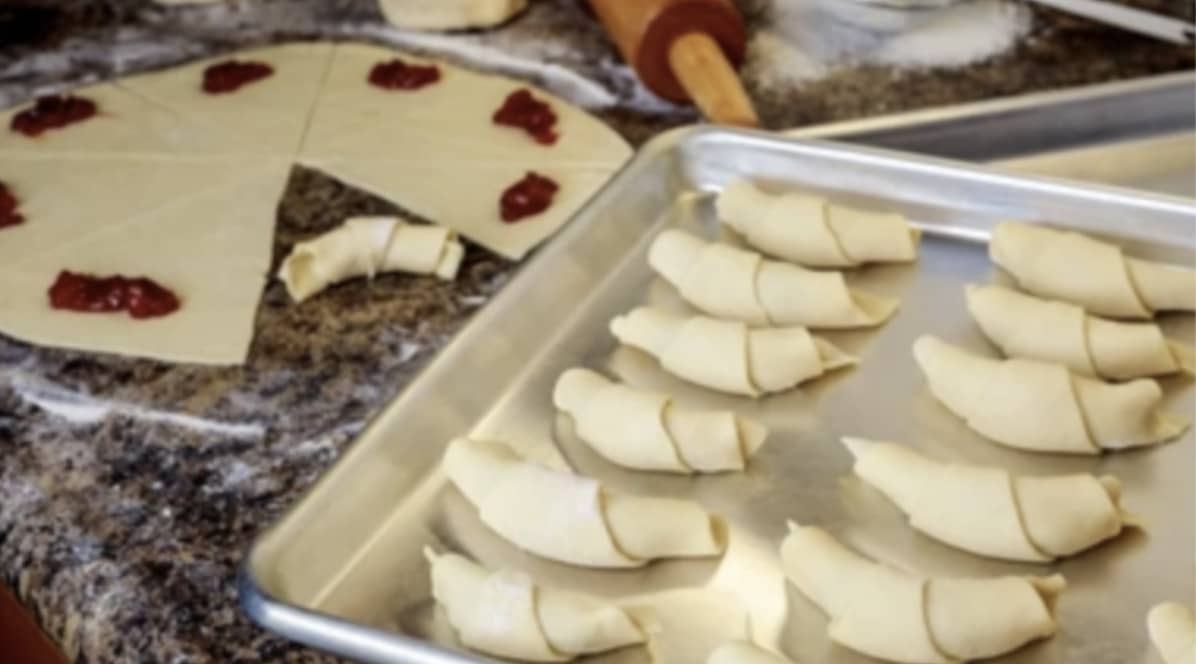Understanding the Difference Between Crescent Rolls and Croissants
Let’s keep it real—at first glance, crescent rolls and croissants look pretty similar. Both have that crescent moon shape, golden brown crust, and they’re soft enough to pull apart. But there’s a lot more to these baked goodies than meets the eye. Think of crescent rolls as the friendly, down-to-earth cousin and croissants as the sophisticated French relative who loves to show off their flaky layers.
So, why the mix-up? Well, crescent rolls are sometimes marketed as “easy croissants,” especially in the U.S. They come in those iconic tubes you pop open (you know, the ones that make you jump!) and are super convenient. On the flip side, croissants are an art form. They require time, technique, and love—like a symphony of butter and dough.
Table of contents
The Origins of Crescent Rolls and Croissants
Crescent rolls, as we know them today, have humble beginnings. They’re the brainchild of the American food industry, designed for simplicity and convenience. Companies like Pillsbury popularized the pre-made crescent roll dough in the 1960s, making it a staple for quick breakfasts, snacks, and even party appetizers.
But did you know crescent-shaped bread actually dates back centuries? In Europe, baked goods in the shape of crescents were common, symbolizing victory or good fortune. They weren’t as flaky or buttery as croissants, though—they were more like soft rolls with a tender texture.
The French Heritage of Croissants
Now let’s talk about croissants—the Parisian icon. Croissants are rooted in French baking traditions, but their origin story starts in Austria. That’s right! The croissant’s ancestor is the kipferl, a crescent-shaped bread from Vienna. The French took this concept and elevated it with puff pastry techniques, layering dough and butter to create that famous flakiness we all adore.
Fun fact: Croissants became synonymous with French culture in the early 20th century, and today, they’re practically a national treasure. Stroll into any Parisian bakery, and you’ll find fresh croissants stacked like edible works of art. 🥐
“Croissants are a celebration of craftsmanship, while crescent rolls are all about convenience.”
Key Ingredients: How Crescent Rolls and Croissants Differ

The Role of Butter in Croissants vs. Crescent Rolls
If croissants had a personality, butter would be its soul. Croissants rely on lamination, a meticulous process of folding and rolling dough with layers of butter. This creates those delicate, flaky layers that almost melt in your mouth. Crescent rolls, on the other hand, use far less butter in their dough, resulting in a softer, bread-like texture.
Think of it this way: if croissants are like a multi-layered wedding cake, crescent rolls are a simple but tasty loaf of bread. Both are delicious but in completely different ways!
Yeast and Dough Variations: A Comparison
Croissant dough is enriched, meaning it contains milk, sugar, and butter for a richer flavor. It’s also yeast-leavened, which helps it rise and puff up. Crescent rolls use a simpler dough that’s more bread-like, and while they also use yeast, the texture is less structured.
Here’s the kicker: croissant dough is kneaded less, which allows for that tender, flaky bite. Crescent roll dough, meanwhile, is kneaded more, giving it a chewier, bread-like consistency.
Added Ingredients: Sweet vs. Savory
Croissants are typically served plain or with fillings like chocolate, almond paste, or ham and cheese. They lean toward the rich and indulgent side. Crescent rolls, however, are more versatile. You’ll find them stuffed with anything from cream cheese to pepperoni or brushed with garlic butter for a savory twist.
Pro Tip: If you’re looking for a shortcut to impress guests, crescent rolls are your go-to for quick and creative recipes. Croissants? Save those for when you want to wow someone with your baking skills!
The Baking Process: What Sets Them Apart?
Rolling Techniques: Crescent Shape vs. Classic Croissant Layers
When you make crescent rolls, you simply roll up triangular pieces of dough and curve them into a crescent shape. Easy, right? Croissants, however, are a labor of love. The dough is rolled, folded, chilled, and repeated several times to create thin layers of butter and dough. This technique, called lamination, is what gives croissants their signature flakiness.
Baking Temperatures and Times
Crescent rolls are baked at a lower temperature, around 375°F (190°C), for about 10-12 minutes. Croissants, on the other hand, require a higher temperature (around 400°F/200°C) to create that perfect golden crust while keeping the inside light and airy.
“Croissants demand patience, while crescent rolls offer instant gratification.”
Texture and Taste: Crescent Rolls vs. Croissants
When it comes to texture and taste, crescent rolls and croissants might seem like distant cousins. Each offers a unique experience for your taste buds, but they couldn’t be more different in how they feel and taste. Let’s dig in!
Flaky Layers vs. Soft Bread-Like Texture
Picture this: you pull apart a croissant, and thin, golden flakes drift off like confetti. Croissants are defined by their airy layers, thanks to the meticulous lamination process. Each bite has a delicate crunch that gives way to a buttery softness on the inside. It’s like biting into a crispy cloud of flavor.
Crescent rolls, however, don’t aspire to that level of flakiness. Instead, they’re all about a soft, pillowy texture. When you bite into one, it feels more like bread—light and tender, with just a hint of chewiness. This makes crescent rolls a great blank canvas for all kinds of recipes.
Sweetness and Savory Notes: What to Expect
Croissants lean heavily on buttery goodness, with subtle sweetness and richness. Think of them as the elegant treat you’d enjoy with coffee or tea. Crescent rolls, by contrast, are more neutral. They have a mild flavor profile, which means you can dress them up however you want—sweet, savory, or even spicy!
Fun Fact: Crescent rolls are like the chameleons of the baking world. You can pair them with chocolate chips, wrap them around hot dogs, or even turn them into mini-pizzas. Croissants, on the other hand, like to stick to their classic repertoire.
“If croissants are poetry, crescent rolls are the catchy pop song you can’t stop humming.” 🎶
Common Misconceptions About Crescent Rolls and Croissants

Despite their differences, many people still confuse crescent rolls with croissants—or think one can replace the other. Let’s bust some of the most common myths.
Are Crescent Rolls Just a Cheaper Version of Croissants?
This one comes up a lot, but the answer is a big fat no. Crescent rolls and croissants might look similar, but they serve completely different purposes. Crescent rolls are designed to be simple and versatile, perfect for quick meals or creative recipes. Croissants, on the other hand, are all about craftsmanship and tradition.
Think of it this way: crescent rolls are like a store-bought instant coffee that gets the job done, while croissants are the artisanal latte made by a barista who really cares about foam art.
Can You Use Crescent Roll Dough to Make Croissants?
It’s tempting to think you can roll crescent dough thin, fold in some butter, and call it a croissant. But the truth is, crescent dough just doesn’t have the same structure. Croissant dough requires hours of chilling, folding, and layering to create the flaky magic we all love. Crescent roll dough is too soft and lacks the elasticity needed for lamination.
Sure, you can try to make crescent rolls look like croissants, but they’ll still taste like crescent rolls. And that’s okay! Crescent rolls don’t need to be croissants to be amazing.
Pro Tip: If you’re short on time but craving croissant-like vibes, try store-bought puff pastry. It’s closer to croissant dough and works wonders in a pinch.
Popular Uses for Crescent Rolls and Croissants
Both crescent rolls and croissants shine in different culinary situations. Let’s explore how you can put these pastries to work in your kitchen.
Breakfast Dishes
Croissants are the gold standard for breakfast. Pair one with jam, butter, or even a rich cappuccino, and you’ve got a meal fit for a Parisian café. For a savory twist, try a ham-and-cheese croissant. The buttery layers soak up the flavors beautifully.
Crescent rolls, however, are the MVPs of quick and easy breakfast ideas. Wrap them around sausages for homemade pigs in a blanket, or stuff them with scrambled eggs and cheese for a grab-and-go breakfast. Feeling sweet? Add a sprinkle of cinnamon sugar before baking for an instant treat.
Appetizers and Party Snacks
Here’s where crescent rolls really shine. Their mild flavor and soft texture make them perfect for appetizers. You can stuff them with cream cheese, spinach dip, or even taco meat for bite-sized snacks that disappear fast at parties.
Croissants, on the other hand, are a bit too delicate for heavy fillings. They’re better suited for light sandwiches or finger foods. Think smoked salmon, brie, or a drizzle of honey. Fancy and fabulous!
Desserts and Pastries
When it comes to dessert, croissants steal the show. Chocolate croissants (pain au chocolat) are a classic for a reason. Their flaky layers and rich filling make every bite pure bliss. Almond croissants, with their nutty sweetness, are another fan favorite.
Crescent rolls, though, are the underdogs of the dessert world. They can be transformed into almost anything—crescent roll apple pies, Nutella-stuffed rolls, or even cheesecake bars. They’re like the pastry equivalent of a blank canvas waiting for your creative touch.
“Crescent rolls are the ultimate kitchen hack, while croissants are the gourmet masterpiece.”
Store-Bought vs. Homemade: Which is Better?
Ah, the age-old debate: should you make crescent rolls and croissants from scratch, or stick to store-bought options? Let’s weigh the pros and cons.
The Pros and Cons of Store-Bought Crescent Rolls
Store-bought crescent rolls are convenient, affordable, and incredibly versatile. They come pre-made, so you can pop them in the oven and have fresh rolls in minutes. Brands like Pillsbury have perfected the formula, making them a reliable choice for busy households.
The downside? Store-bought crescent rolls lack the depth of flavor you’d get from homemade dough. Preservatives load them, which might not be ideal for everyone.
Making Crescent Rolls or Croissants at Home

Making crescent rolls at home is straightforward and fun. You can control the ingredients, customize the flavors, and even experiment with different fillings. Plus, nothing beats the smell of fresh-baked rolls wafting through your kitchen.
Croissants, however, are a different story. They require patience, skill, and a whole lot of butter. The process can take up to 12 hours (or more!), but the results are absolutely worth it. Homemade croissants are buttery, flaky, and so much better than anything you’d find in a store.
Fun Fact: Croissant-making is considered an art form in French bakeries, and bakers train for years to perfect the technique.
Common Problems When Making Crescent Rolls and Croissants
Even experienced bakers face issues when making crescent rolls or croissants. Let’s tackle some common problems and solutions!
Dough Not Rising Properly
A flat dough is often due to expired yeast or improper temperature. Make sure your yeast is fresh, and let the dough rise in a warm place—about 75°F (24°C) is ideal. If your kitchen is too cold, place the dough in an oven with the light on to create warmth.
Soggy Pastries
Soggy croissants or crescent rolls happen when the dough hasn’t been properly layered or if there’s too much filling. For croissants, ensure your layers are thin, and for crescent rolls, use minimal filling. Bake until golden brown to avoid underbaking.
Over or Underbaking
Croissants take longer to bake than crescent rolls. Be sure to check them at the recommended time, but keep an eye on them in the last few minutes. For croissants, an internal temperature of 190°F (88°C) is ideal, while crescent rolls should be golden when done.
Tips for Perfect Pastries
Use Fresh Ingredients
Fresh butter and yeast are crucial for both pastries. Use unsalted butter for croissants and high-quality flour for both crescent rolls and croissants. For a softer texture, all-purpose flour works best for crescent rolls.
Master Rolling and Shaping
For croissants, roll the dough thinly and cut into triangles. Roll them tightly to get the signature crescent shape. Crescent rolls are easier—just roll the dough from the wide end of the triangle and curve the ends.
Crescent Rolls vs. Croissants in Recipes
Crescent rolls and croissants can often be swapped, but the texture and flakiness of a true croissant can’t be replicated with crescent dough. Use crescent rolls for quick snacks or breakfast items, while croissants shine in gourmet pastries or simple butter-and-jam breakfasts.
Nutritional Comparison: Crescent Rolls vs. Croissants
Both pastries are high in calories and fat, but croissants tend to be the higher-calorie option, thanks to the layers of butter. A typical croissant has 200-300 calories, while crescent rolls are usually around 150-200 calories.
Both are low in fiber and protein, so enjoy them in moderation as part of an indulgent meal. Crescent rolls are slightly lighter, but neither is a healthy snack.

